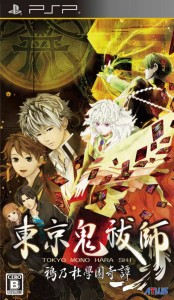 Tokyo Mono Hara Shi: Karasu no Mori Gakuen Kitan
Tokyo Mono Hara Shi: Karasu no Mori Gakuen Kitan, to give its full name, is a spin-off of the Tokyo Majin Gakuen series. I’d never even heard of Tokyo Majin before I tried this, and apparently none of the games in the series have been released in the west. This despite the fact that they contain many of the same elements that made Atlus’s Persona games so popular: high school kids, relationship building, occult happenings and dungeon crawling. If Tokyo Mono Hara Shi is any indication, the reason this series has stayed in Japan might be because it’s far too dull, slow, wordy and ultimately unrewarding for the average gamer.
Dungeon crawling (i.e. the good bits)
Wikipedia describes Tokyo Mono Hara Shi as “a combination of visual novel and dungeon crawler.” Any time a game has “visual novel” anywhere in its description, that means 95% visual novel and 5% whatever the other thing is. If the ratio was any less, it would just be a normal RPG, yes? Good. So I knew what I was getting into.
Let’s cover the dungeon crawling first, since it takes up so little gaming time. You move based on a grid with a first-person view, like this:
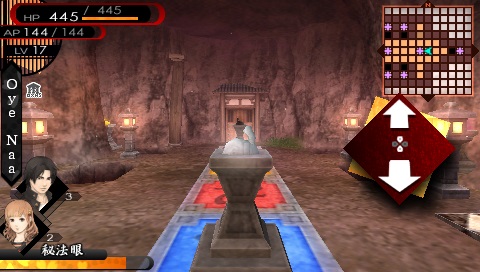 Solve puzzles to progress, e.g. slot this tab into this hole to lower the water, drag this statue onto this slab to unlock the door as I was doing in the screenshot above, etc. Nothing very challenging. Most dungeons are fairly short, and your puzzles stay solved even if you warp out. Encounters are fixed per room and plenty of rooms have no enemies at all.
Solve puzzles to progress, e.g. slot this tab into this hole to lower the water, drag this statue onto this slab to unlock the door as I was doing in the screenshot above, etc. Nothing very challenging. Most dungeons are fairly short, and your puzzles stay solved even if you warp out. Encounters are fixed per room and plenty of rooms have no enemies at all.
Combat
Turn-based first person. Two allies accompany you, but each ally has only one ability that they can use a few times each, e.g. physical attack, heal, counter. You’ll have to do the bulk of the work yourself. Hit, move and heal until you run out of AP and then end your turn. Once the enemy moves and ends their turn, you get a full AP refill, and on it goes.
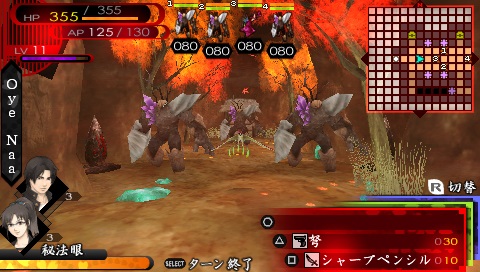 The yellowish-green bar above the enemy icon represents the enemy’s regular HP and the orange bar above that represents “weak spot” HP. Every enemy has a weak spot that you can target to defeat them more easily. E.g. a boss with 5000 HP might have a weak spot HP of 3500. Finding the spot isn’t always easy, but it pays off in the end.
The yellowish-green bar above the enemy icon represents the enemy’s regular HP and the orange bar above that represents “weak spot” HP. Every enemy has a weak spot that you can target to defeat them more easily. E.g. a boss with 5000 HP might have a weak spot HP of 3500. Finding the spot isn’t always easy, but it pays off in the end.
It was an interesting and fairly challenging system early on, when my AP was low, all my weapons were AP-guzzlers and I didn’t have a lot of AP refilling items. By the middle of the game, though, I’d hit upon a tedious but effective strategy that made a joke of the whole affair. First, a bow that does a decent amount of damage for only 5 AP. Second, AP refills out the wazoo. Chip away at the boss’s health until I’m almost out of AP, use an item or two, keep chipping away. Your turn doesn’t end until you run out of AP, remember? Once I had higher end items like sushi (+90AP), the bosses never stood a chance.
Well, most of the time. Once in a while, I decided to be sporting and give them a turn. Little did they know I had a party member who could make me invisible. Once I’d beaten the boss up a bit, I used his skill, ended my turn and watched the enemy’s turn end automatically because he couldn’t find me. Hey, he had his chance. 😉
The level up and stat distribution system is done up to look like a report card:
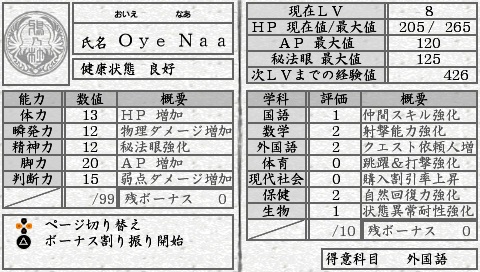 The stuff on the left is for raising HP, AP, physical damage, weak point damage, etc. The stuff on the right affects things like jump range, usefulness of ally skills, auto-recover, stat defense and shop prices. The allies that accompany you affect your stats, so you have to distribute points with that in mind. For example, if you know your final party will include someone who gives +5 to AP, then you only need to raise AP to 94. And so on and so forth. It’s not that deep, and as long as you have lots of AP it’s hard to go wrong.
The stuff on the left is for raising HP, AP, physical damage, weak point damage, etc. The stuff on the right affects things like jump range, usefulness of ally skills, auto-recover, stat defense and shop prices. The allies that accompany you affect your stats, so you have to distribute points with that in mind. For example, if you know your final party will include someone who gives +5 to AP, then you only need to raise AP to 94. And so on and so forth. It’s not that deep, and as long as you have lots of AP it’s hard to go wrong.
The Hanafuda mechanic
Hanafuda are Japanese playing cards with flower motifs on them. Tokyo Mono Hara Shi’s story goes like this: special hanafuda cards have gone out of control and it’s your job to gather them and seal them again at the expense of your life. One might expect the plot to be a little hard to follow for non-Japanese, seeing as the game revolves around an aspect of specifically Japanese culture. But actually, no, the hanafuda might as well be regular playing cards for all the relevance they have. I’m telling you this from experience, since I knew *bleep*-all about hanafuda before playing this and still know *bleep*-all now.
That’s not to say the cards are completely useless. They have their functions and special effects within the game. You can apply them to your armor and weapons, for example. In the shot on the right, I added a card to my wooden bat to make the monstrous spiked club you see there. Boy does it pack a wallop!
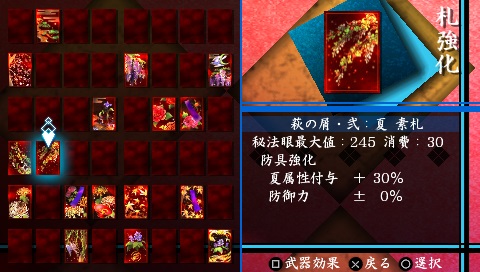 |
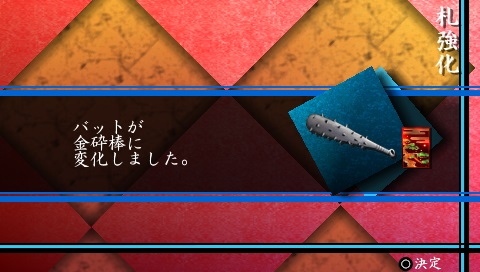 |
Other cards help you destroy obstacles or fly or navigate the dungeon in other ways, and all of them have effects (e.g. +50% EXP) that can be activated by dropping them on the ground. There’s no question that they’re useful. It’s just that there was no point to making them hanafuda at all. They could have used any random colored cards or accessories or puzzle pieces and nothing would have changed. What I’m saying is, if they had to drag in an item from Japanese culture and they had to make it hanafuda, they should have put a little more effort and imagination into it. Build a little backstory at least for the special cards, make them have effects that are directly related to their design. Make sure there’s a point to using hanafuda in particular, otherwise it’s just a pretty but pointless gimmick.
The visual novel
Wake up, go to school, save the world. Along the way, talk to lots of people and make lots of choices. Before school you talk to the people in your house, then the people in the garden, then your classmates before school, then during lunch, then after school and then they let you enter the dungeons. I counted 50 choices in one chapter alone, and I wasn’t even halfway done yet. Lots of talking isn’t necessarily a bad thing as long as the dialogue is interesting and the characters are worth interacting with, but, well… just look at this guy:
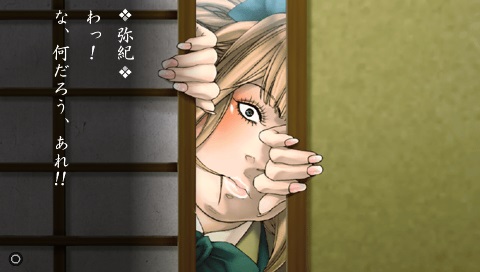 Yeah, it’s a guy. And he’s not even the weirdest of the bunch. Everyone’s either a bland, uninspiring yes-man to the main character or just flat out insane. Like this wannabe-hero:
Yeah, it’s a guy. And he’s not even the weirdest of the bunch. Everyone’s either a bland, uninspiring yes-man to the main character or just flat out insane. Like this wannabe-hero:
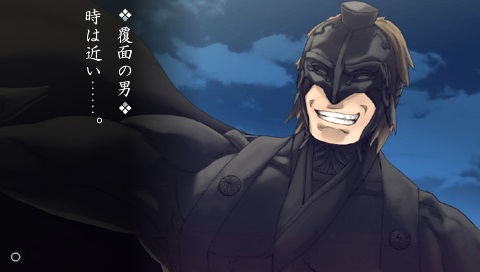 Being nuts doesn’t necessarily make a character interesting. Btw, when you spend all that time talking to them, don’t expect to learn much about them or about the story. Most of the choices are things like “How do you like your eggs?” and “How are you liking this school?” Any real story will be info-dumped on you either right before you start a dungeon or right after you kill the dungeon boss.
Being nuts doesn’t necessarily make a character interesting. Btw, when you spend all that time talking to them, don’t expect to learn much about them or about the story. Most of the choices are things like “How do you like your eggs?” and “How are you liking this school?” Any real story will be info-dumped on you either right before you start a dungeon or right after you kill the dungeon boss.
Speaking of choices, they’re a little different in this game. Instead of picking a line to speak, you usually indicate one of 8 emotions. For example you indicate that you’re Happy if you’re happy about what was just said or Sad if you’re sad, that sort of thing.
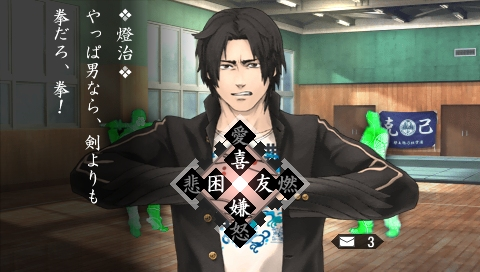 If you choose right, you hear a little tune play and the character’s invisible friendliness meter goes up. And it’s important to choose right as often as possible, otherwise you’re headed directly for…
If you choose right, you hear a little tune play and the character’s invisible friendliness meter goes up. And it’s important to choose right as often as possible, otherwise you’re headed directly for…
The bad end
Actually, unless you’re playing with a guide, you’re headed for the bad end regardless. I did my best, reloaded when I got a bad response, lived right as best as I could and was still locked into the bad ending in chapter 9. Sure, I’ve played other games where a bad ending was all but unavoidable without a guide. Nora to Toki no Koubou, for example (also by Atlus, come to think of it). Except Nora was 9 hours long for the first playthrough and only needed you to do one or two things right to get the good end, while this is 50 hours long with literally hundreds of choices to make along the way.
I should be really mad that I played so many hours only to get locked into one of two bad ends (1: You die, 2: You don’t die, but mankind will probably be destroyed). I should be, but somehow I’m not. A little annoyed, a little frustrated, a little disappointed, but not angry. I think I’ve burned out all my rage on other games with similar problems. Blade Dancer, for example, had nothing but a bad ending. Saga 3 had a perfectly good ending, but I missed out on the “True” ending because of a few minor mistakes. Even with my beloved Phantasy Star Portable, I could easily have ended up with a bad ending if I had made a few wrong turns, and of course Vivienne still blanks me in the next game regardless. Of course, all these game were quite a bit shorter than Tokyo Mono Hara Shi, and just because others are doing it doesn’t make it any less of a terrible idea, but… Nope, I still can’t muster up the energy to get angry, and the story isn’t compelling enough to replay for the good end, so that’s the end of that.
Tl;dr summary
What’s good: the character and monster designs are nice. Dungeon puzzles don’t get in the way of progression. Bosses are tough but beatable. Combat is interesting until you break it. A simple item crafting system lets you make very helpful items. The various card effects are a cool touch and the cards themselves are pretty. Music and voices are all pretty good.
What’s not so good: Not much variation in dungeons. Too many characters, too many sycophants and too many weirdos. Too much dialogue about unimportant things. Must follow a FAQ slavishly to avoid a bad end. Sidequest system is vague, repetitive and frustrating. Hanafuda gimmick is all but wasted. Not much story until right before the bad end when they dump a ton of stuff on you at once.
Not that good a game, and not even bad enough to be memorable. The only useful thing I got out of this experience was, umm… Hmm, I got an idea of what Tokyo Majin Gakuen games are like. And I gained a little more respect for localization companies. Sometimes when they refuse to localize a certain game they’re actually protecting us all from lifeless dross like Tokyo Mono Hara Shi. Food for thought.

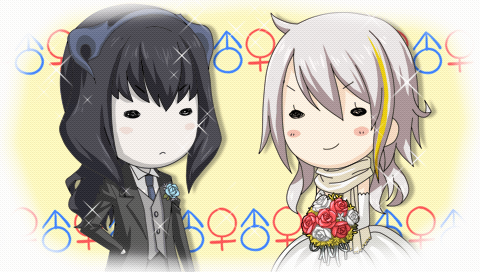
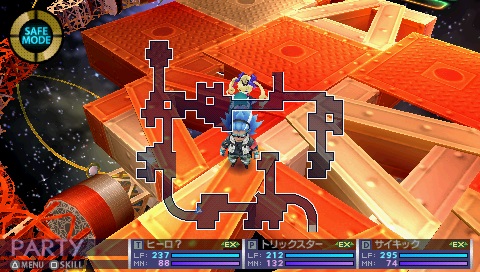
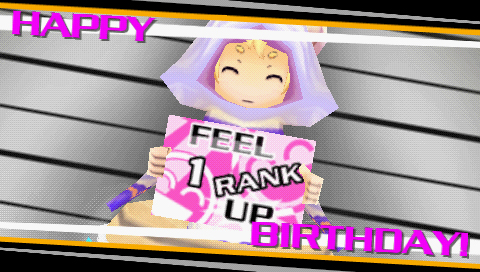
Thanks a lot for this review! It shed a lot of light over this series, I had heard about it but there’s little information in english, and the information in wikipedia is not enough to understand how combat works. Quite interesting, in fact.
Too bad most of it is Visual Novel-Style: if it were dungeon crawler most of the time, maybe I’d play it, considering I’ve beaten a few in japanese even if I don’t speak it.
Glad it helped. Of course this is a spin-off, not the main series. I hear the main series is more SRPG-like. The dungeon crawling isn’t bad, but it’ll be too easy for you if you’ve played other such games so I wouldn’t bother if I were you.